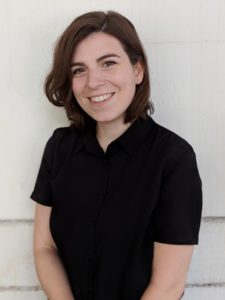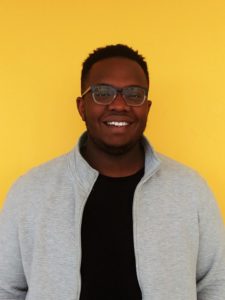 Orli Hakanoglu
Orli Hakanoglu
2018 Payette Sho-Ping Chin Memorial Scholar
May 2019 Graduate, Yale University
It has been [a few months] since I graduated with my M-Arch degree from Yale, and have had a bit of time to relax and reflect on the past three incredible years. When I started school, I had no idea what world I was about to enter; all I knew was my own curiosity and eagerness to join a community that spoke my language. What I didn’t anticipate was the richness of this language, and that it had such a wealth of “dialects,” so to speak. I was introduced to countless angles of investigation that greatly expanded my understanding of the process of design. Anchoring me and my peers’ exploration was an understanding of history, context, and an essential reflexivity about the role of the profession itself. This multifaceted quality of inquiry was encouraged from all directions: students, faculty, visiting critics and jurors, members of the University, and the broader New Haven community.
The semester-long teaching fellowships I held were probably the highlight of my time at Yale, particularly those in which I was given a hands-on role as an instructor. I would have never imagined that my own knowledge of the subject could be so deepened through work with brilliant peers only a year or two my junior. The school’s encouragement of a richness of perspective and ways of seeing is likely its most powerful pedagogical tool, and I hope to cultivate the same open-mindedness within the communities I belong to in my post-graduate life. I am endlessly thankful to Payette and the Architects Foundation for their support in making this education possible for me. Having graduated, I am now ready to experience the aspects of the profession less dwelled-upon in the classroom, and am planning my next steps as an architect with optimism and excitement.
 Vaughn Lewis
Vaughn Lewis
2014 Diversity Advancement Scholar, AF/McAslan Fellow
May 2019 Graduate, The Cooper Union
My acceptance into The Irwin S. Chanin School of Architecture at The Cooper Union in 2014 was an incredible opportunity which was both exciting and challenging. It came at a difficult time, a complex year in the 155-year history of the institution when there was a change in Cooper’s tuition policy. Because of this, my first studio Architectonics, led by David Gersten with Wes Rozen and Rikke Jørgensen, was the most formative during my education. In that semester my professors worked to create situations within which the students could inhabit questions and create new works that would embody the current moment in the life of the institution. Together with my classmates, we measured, drew and built a six-foot-high scaled model of the Foundation Building’s exterior, filled with each student’s interpretation of salient interior spaces. Speaking metaphorically, our professors placed the weight of the school in our hands, to care for the school in the most profound sense of “building it.” We built a model of The Cooper Union while acknowledging that The Cooper Union is itself a model of education. This approach was unlike anything I thought studying architecture would be and as a result of this experience, each studio thereafter became a social poetic act, a collection of gestures of ethics and imagination.
Throughout my studies, I committed myself to seek out programs which would provide me the foundation I needed to become a valuable member of any design team. Aside from my design studios and classes, it was extremely important to me that I supplemented my education with teaching. I learned about the school of architecture while I was in high school and attending a Cooper Union pre-college program called The Saturday Program. The program offered free studio art courses to New York City Public High School students and gave students individual advisement on applying to colleges along with preparing their art and architecture portfolios. It was because of this program that I gained the necessary skills I needed to create a competitive application for acceptance to The Cooper Union. So in my sophomore year, I became an instructor and taught a class each semester thereafter until I graduated. It was important for me to help give to others what was given to me because I fully understand that service is the price we
pay for the space we occupy.
I also received several prominent scholarships/grants and fellowships including: a grant from The National Science Foundation, 2018 William Cooper Mack Thesis Fellowship, 2017 Palmer Hayden Travel Fellowship and the 2015 AIA /AF Diversity Scholarship. These fellowships and organizations have provided me with a tremendous amount of financial and moral support. As a result of these opportunities, I was fortunate enough to travel to places like Mexico, Italy, Germany, Hong Kong, China, and Africa.
An integral aspect of architecture is its engagement with different cultures and communities around the world. Furthermore, I pursued architecture fully aware of the disparity between the total number of African American in the U.S. population and the percentage of licensed African-American architects.
However, I believe that without greater diversity in the architecture field, the profession threatens to limit its views, perspectives, and ideas. As we live in a multicultural society, it is my belief that the architecture profession should support professionals who reflect and represent the diverse communities they serve.
 Jalen Price
Jalen Price
2014 Diversity Advancement Scholar
May 2019 Graduate, Drury University
My time in architecture school is one of the most rewarding and challenging experiences in my life. Going into this course of study, I had a base understanding of architecture. I was unaware of the depth at which architects and other design professions do impact society. Throughout my five years at Drury University, I grew as a person and largely as a designer. I was challenged to design in a variety of typologies and user groups. My designs ranged from a singular space to complexes, to a 25-year master plan. Outside of design, I solidified my commitment to using design to impact my community through the student organizations Art of Space and the American Institute of Architecture Students (AIAS). I was able to grow my leadership skills as a Residential Assistant for the university.
In addition to working part-time, keeping up with course requirements, and participating in various organizations, I am proud of receiving the following recognition during my time in architecture school: Three-time recipient of a scholarship from the AIA St. Louis Scholarship Fund; Community Award recipient from the Hammons School of Architecture; and Alpha Rho Chi Bronze Medal recipient from the Hammons School of Architecture. I completed two architecture internships. I was a Summer Intern with Grice Group Architects -St. Louis, MO in 2017. I completed a Spring internship with Agency Landscape and Planning – Cambridge, MA in 2019.
As I enter the professional world, I will begin with a position as an Architectural Designer with BRR Architecture in Kansas City, MO. I am excited to see where this opportunity takes me. I carry two pieces of advice as I begin this phase of my life. A professor once told me keep growing and refuse to become stagnant in my path as a designer and person. The second piece of advice came from a mentor who told to always seize opportunities from those who believe in me. The intersection of design and positive community impact I learned at Drury has sparked an interest in urban design; therefore, I plan to pursue an additional degree in the future.
